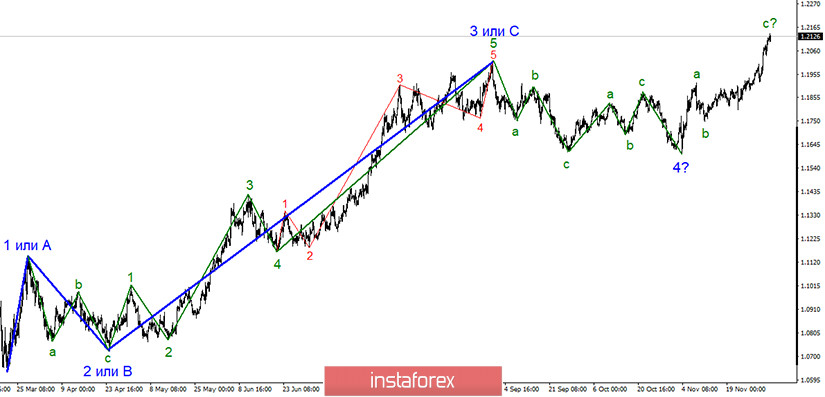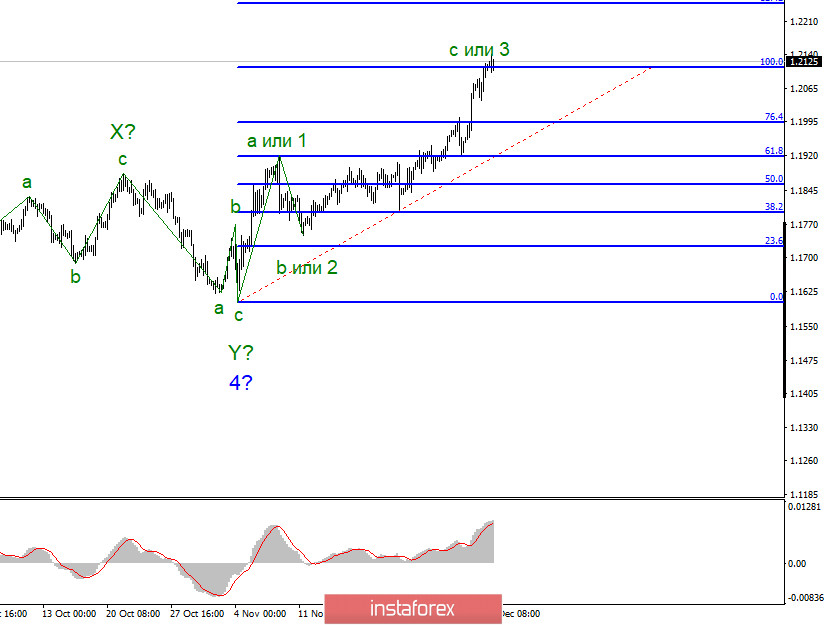
The wave pattern of the EUR/USD pair has not yet taken a clear form but in general, it is quite predictable. The ascending C wave continues its formation and has made a successful attempt to break through the high of the wave 3 or C. Thus, the next three ascending waves continue to form. Also, the ascending section of the current trend can now be identified as a new wave 5.

The wave pattern on a smaller time frame also indicates the formation of the next three-wave section of the trend. It is also possible that the pair has resumed the ascending section within the major wave 5 which started to form on March 20. A successful attempt to break above the high of the 3 or C wave will signal the continuation of the bullish trend on the euro. At the same time, the new Fibonacci grid based on the first wave size indicates that the implied wave 5 is much stronger.
The European currency remains in high demand in the foreign exchange market. In previous articles, I have already explained why the euro is strengthening. Now I would like to focus on the reasons that can limit the euro's rise. Earlier this fall, Philip Lane, the ECB chief economist, warned that the euro's current exchange rate is too high which can negatively influence the trade balance of the European Union. A strong euro makes European goods more expensive in the world markets. Back then, the rate was 1.17-1.19 dollars per 1 euro. Now the quotes have moved even higher to the area of 21. Could the ECB launch the notorious currency intervention in order to weaken the euro? I don't think so. Therefore, we should not count on the ECB support. At the moment, the regulator is facing a lot of challenges, including negative interest rates and the need to stimulate the EU economy due to the second COVID-19 and the repeated lockdowns. It is unlikely that the ECB will be able to successfully conduct foreign exchange interventions. After all, what is an intervention? It is an increase or decrease in the supply of a particular currency on global currency markets. That is, if the euro is too expensive, the ECB needs to flood the market with the euro in order to increase its supply. However, we are talking about tens of billions of euros. The regulator will either have to print them or resort to the capital markets. Moreover, other countries, including the US, are also stimulating their economies, pouring billions and even trillions of dollars or other currencies into the markets. So, global central banks cannot print an unlimited amount of money to simply depreciate their currencies. Four years ago, Donald Trump said the US dollar rate was too high and aimed to ease it by all means. He did not succeed, though. Actually, it is not an easy task to manipulate the exchange rate. Moreover, if China or the United States suspects the EU authorities of manipulating the euro's rate, then accusations or even sanctions will follow.
Conclusion and trading tips
Supposedly, the euro/dollar pair continues to build a three-wave ascending section of the trend which can be completed soon. Thus, I recommend being extremely cautious when buying the pair. It is better to consider selling the instrument. Nevertheless, it is still possible to go long on the pair, following every new MACD buy signal with the targets located near the 1.2250 and 1.2430 levels. They correlate to 127.2% and 161.8% Fibonacci.
 English
English 
 Русский
Русский Bahasa Indonesia
Bahasa Indonesia Bahasa Malay
Bahasa Malay ไทย
ไทย Español
Español Deutsch
Deutsch Български
Български Français
Français Tiếng Việt
Tiếng Việt 中文
中文 বাংলা
বাংলা हिन्दी
हिन्दी Čeština
Čeština Українська
Українська Română
Română

